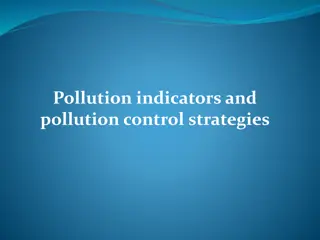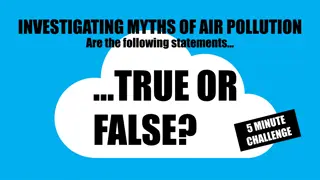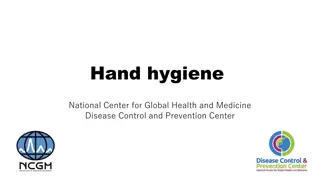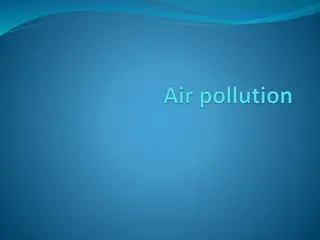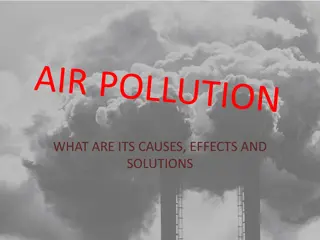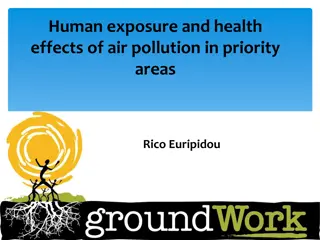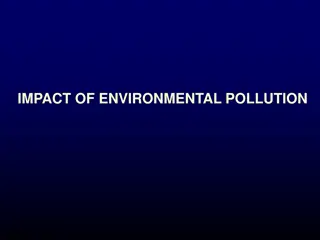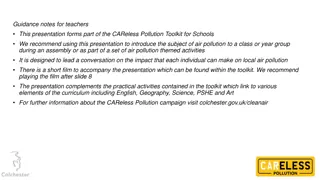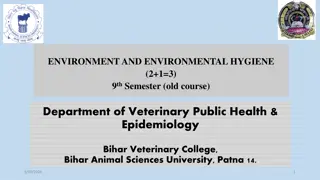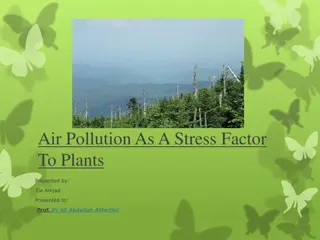Understanding Environmental Hygiene: Air Pollution and Composition of Air
The content delves into the concept of atmospheric pollution, the composition of pure and impure air, sources of air pollution, and the zones of the atmosphere. It highlights the detrimental effects of pollutants on health and the environment, emphasizing the importance of environmental hygiene. The composition of fresh air and the impact of human activities on air quality are explored in detail. Natural and anthropogenic sources of pollution are discussed, underlining the need for collective action to combat air pollution and preserve the quality of the atmosphere.
Download Presentation

Please find below an Image/Link to download the presentation.
The content on the website is provided AS IS for your information and personal use only. It may not be sold, licensed, or shared on other websites without obtaining consent from the author. Download presentation by click this link. If you encounter any issues during the download, it is possible that the publisher has removed the file from their server.
E N D
Presentation Transcript
UNIT-IV Environmental Hygiene (Credit Hours-3+1)
Introduction Atmosphere: Gaseous envelope surroundinga celestial body (earth) It consists of a mixtureof gases (air): vital for the propagationof life processes Atmospheric pollution: The presence of substances in air in concentrations sufficient to cause harmful effects on the health of animals & man, vegetation & property or to interfere with the enjoyment of life & property Pollution: means to make (air) impure or unwholesome (Presence of dust, smoke, fumes, mist, odour or gases (including oxides of carbon, sulphur & nitrogen) in quantities or of a duration that unreasonably alters the average (acceptable purity) condition of the atmosphere)
Pure and impure air The composition (%) of fresh (pure) air by volume: Component Nitrogen Oxygen Argon Total Neon Helium Krypton and methane Hydrogen and Nitrous oxide Percent 20.946 78.084 0.934 99.964 0.0018 0.0005 0.0001 0.00005 Xenon 0.000008 Variable components: Vapour 0-5 Carbon dioxide Ozone Sulphur dioxide 0.01-0.1 (average 0.032) 0-0.01 0-0.0001
Composition of air Cont The composition: Change of season, Altitude & Solar activity Oxygen: highly reactive (oxidation) Exerts marked influence on various geochemical cycles Most of the atmospheric oxygen: photosynthesis & ultravioletradioactivity Expired air: concentration reduced to 16.4% concentration of CO2increased to 4.24% concentration of other gases: unaltered
Sources of pollution The pollution of outdoor air from: diverse sources Cause of pollution is traced to one or more of human activities Ex. Combustion of coal & oil: pollution by SO2, CO2 & NO The treatment of wastes: release ammonia & H2S in the atmosphere The nature of pollution in an area will, therefore, be related to the type of activities indulged in by the communities inhabiting the area Many natural sources: volcanoes and forest fires
Zones of atmosphere Zones: Homosphere: chemically uniform up to above 100- 120 km the earth Heterosphere: above homosphere, structurally uneven Altitude increases: change in temperature pattern of atmosphere On the basis of this change atmosphere has been divided into 4 distinct strata/zones: 1. Trophosphere 2. Stratosphere 3. Mesophere 4. Thermosphere
Zones of atmosphere cont. 1. Troposphere: Immediately above surface of earth, A gradual decline in temperature Thickness: 10-20 km At 20 km the temperature falls to -56O C (from 150 C) The rate of temperature drop: 6.40 C/100 m The zone contains: 99% mass of gases found in the atmosphere (nitrogen, oxygen and carbon dioxide) 2. Stratosphere: Height from the earth: 40-50 km Thin layer above troposphere Uniform temperature The zone comprises of ozone layer Protects the earth against the ill-effects of UV irradiation Ozone shield increases the temperature from - 560 C to -20 C at 50 km height 3. Mesophere: Height from the earth: 70-80 km Marked reduction in the temperature At an altitude of 70 km, the temperature falls to -92oC (from -20C) 4. Thermosphere: Height from the earth: above 80 km Temperature: very high (upto 12000 C) Thickness of the zone is 500 km It contains O2, nascent oxygen & nitrogen oxide.
Influence of metrological conditions The atmospheric pollution is influenced: meteorological conditions present in an area Meteorological factors influences: magnitude of vertical & horizontal transfer of air pollution Major parameters are: Temperature: Direct bearing on the movement of air pollutants Influences the diffusion of pollutants Wind: The direction & speed of wind is an important determinant in the movement of air pollutants Humidity Influences the precipitation of pollutants on earth Many toxic pollutants combine with water vapor precipitate to the surface of earth Atmospheric pressure Influenced the movement of pollutants in an area Important consideration for many pollutional parameter
Air pollution: a historical perspective 1. Meuse Valley (Belgium), December, 1930 The area was covered by a blanket of thick fog for about 5 days More than 60 persons died as a result of toxicity due to oxides of sulphur (and metals) & soot A large section of the population became ill 2. Donora (Pennsylvania), October, 1948 Intense foggy condition that lasted few days. A large proportion of the population (more than 40%) became ill due to exposure to Manifested ocular & throat irritation, cough & other respiratory symptoms &vomiting Caused due to excessive sulphur compounds including sulphuric acid from industries
Air pollution: a historical perspective 3. London, December, 1952, 1962 Famous smog disaster (1952) for 5 days Death of thousands people, children & the old Caused acute respiratory disease in cattle Another episode of smog (Dec., 1962) that also caused substantial morbidity& mortality Sulphur compounds: probable causes of the illness 4. New York (United States) Air pollution disasters were reported during 1953, 1962 & 1966 The smog caused substantial morbidity and mortality in 1962 5. Bhopal (India),1984 Leakage of a toxic gas (methyl isocynate) from a pesticide plant. More than 5000 people died Many more thousands were affected by a variety of illnesses including respiratory dysfunction, blindness & deformities in the infants
Air pollution: a historical perspective Chernobyl (erstwhile USSR), 1986 Most famous radiation disasters that occurred in as a result of massive leakage of radioactivity from a nuclear reactor The melting of & explosion in the reactor led to death of about 2000 persons & contamination of the environment in the neighboring areas oLos Angeles (California) The smog pollution in the city has more to do with petrol than coal The area is highly industrialized and densely populated The problem that was associated with various respiratory symptoms was recognized as early as 1940(s) Caused ocular & respiratory irritation& damage to vegetation
Air pollution: a historical perspective Coal dust explosion (China, 1942 and Chasnala, India, 1957) Forest fires (South East Asia, 1997-98): impact on health & productivity Nitrogen oxide & hydrocarbons present in the atmosphere (following use of petrol by the automobiles) reacted with sunlight Toxic compounds were produced through a photochemical reaction between sunlight & the two pollutants The photochemical smog pollution of 1969 has been reported in detail as a part of episode 104 (associated with hurricane Camille emanating from Gulf of Mexico)
Classification of air pollutants A wide variety of pollutants are present in the atmosphere In order to understand their impact on health & ecology, & to evolve appropriate strategies for their control, the pollutants are classified in a number of ways: (1) Source of emission, (2) Physico-chemical characteristics & (3) Effects on life processes
Sources of air pollutants Sources Natural sources Man induced activities Incineration: wood, coal, petroleum products, Automobile industry: oxides of sulphur & nitrogen, carbon monoxide, smoke & fly ash Oil refineries Iron/steel mills, fertilizer plants & rendering units metal fumes & fluorides into the atmosphere Agricultural, textile, paper & pharmaceutical industries Dust particles: milling, crushing /grinding pesticide & drug residues Organic/inorganic vapours Geochemical contamination, Photochemical reactions, Change in climatic conditions, Volcanic eruptions, Gaseous discharge from marshes & swamps, Forest fires Dust, fog & radiation fall-outs Microbial agents
Physico-chemical characteristics Two major groups Particulate pollutants: Dust particles, Mist, Fly ash Droplets, Fog, Smoke, Fumes & soot Gaseous pollutants: Oxides of Sulphur & Nitrogen, Carbon monoxide Hydrogen sulphide Vapours trichlorethylene of gasoline & Toxic to animals & man Organic decomposition of waste Methanogenesis: methane (gobar gas) & Carbon dioxide Carbon dioxide: respiration
Effects of pollutants Direct bearing on the health of animals & man, & planetary bio-diversity Toxic gases & substances present in the atmosphere cause: Retardation of growth, Promote ageing, Bleaching of leaves Necrosis in plants The degree of damage: Dose of pollutant & Duration of exposure Loss of valuable plant materials especially around industrial areas damage to physical structures, monuments and buildings. Ex: damage of Taj Mahal
Effects of pollutants Nonirritant pollutants (carbon monoxide) may not always be associated with overt clinical manifestations. Studies have shown that zinc & lead pollution of air: marked fatalities in cattle & horses in Germany Arsenic: Bloody diarrhea, vomiting & excessive thirst in animals Smog pollution: Variety of respiratory problems in animals Lead pollution: Teeth grinding & laryngeal paralysis (roaring sound) in cattle Fluorosis: Cattle & sheep reared near brick kilns and iron/steel aluminum plants & ceramic factories In soil (0.1-1.0 g/kg) Water (in some areas in India, 25 mg/litre) Air (Volcanic eruptions & in the dust particles originating from soil) Conditions: lameness, mottled teeth, fragile bones & loss of milk yield in dairy cattle Metallic pollutants: Induce anaemia & emaciation in animals
Effects of pollutants In humans (atmospheric pollution due to metallic & gaseous substances is manifested by Bronchitis, pulmonary asthma & inflammation of upper respiratory tract Nitrogen oxide: Pulmonary oedema & congestion Sulphur oxide: Injury to mucosa Ozone: Effects similar to ionizing radiation Carbon monoxide: Depriciation of blood oxygen level following its combination with haemoglobin) Particulate matter have been described in detail by many workers
Pollution within animal houses The quality of environment within animal houses: on the health of animals & their productivity High densities of animals: not well ventilated lead to accumulation of excessive moisture and carbon dioxide Atmospheric oxygen level to 10-12% may not prove fatal to animals, An increase of atmospheric Carbon dioxide level to 6.0% may lead to asphyxia A concentration of Carbon dioxide 30% for some hours could result in death In horses Carbon dioxide concentration of 3-5% may cause rapid breathing A combination of high moisture & carbon dioxide makes animals uncomfortable & leads to a reduction in production Major gases: include ammonia, hydrogen sulphide & methane besides carbon dioxide Ammonia: irritating gas that is frequently found in the dirty farm houses Concentration between 0.04% and 0.5% of the gas causes much irritation of mucous membranes, asphyxia and death. Hydrogen sulphide (0.01 - 0.14%): irritation of eyes, throat & nose, & lung oedema Excessive amounts of methane may prove explosive Turbulence activity may also lead to production of harmful particulate pollutants
Microbial pollution of air A variety of microbes are carried by air Meteorological conditions (temperature, humidity, solar radiation) Amount of particulate & gaseous pollutants contribute immensely to the variation in the load and type of microbes Most of the atmospheric microflora emanates from the soil or due to stirring action induced by animal/human activity within the animal houses The microbes are adsorbed on the dust particles Carried over long distances under favorable weather conditions (high wind velocity) especially during outbreaks of diseases A large numbers of organisms (many of them pathogens) can be transmitted through air in an area Animals suffering from respiratory diseases discharge the microorganisms during sneezing & coughing
In man: Sneeze can release upto 10,000-10,00,000 droplets Microbes released by animal & human sources survive in the environment for varying lengths of time Some organisms may not survive for more than few minutes (Leptospira in dry atmosphere), Can resist the adverse environmental conditions for as long as 28 years (spores of Bacillus anthracis in soil) Brucellae can survive in soil for about one month Exposure to sunlight causes destruction of many environmental microorganisms (Mycobacterium spp) In soil: mycobacteria can survive for upto 6 months
Measurement of air contamination The microbial load of moving air is determined To assess the level of contamination within a building or given area Several techniques are used To collect the samples & conduct qualitative & quantitative analysis of air 1. Sedimentation 2. Impaction 3. Impingement 4. Precipitation 5. Filtration 6. Sieve cascade sampler
Methods of air sampling 1. Sedimentation (settling plate method) Permits settlement of atmospheric air on the surface of an agar plate for 10 min or more It does not allow the settlement of suspended particles the air 2. Impaction Collecting the atmospheric particles on the surface of a solid/semi-solid agar medium Air centrifuge is used The air flow on the sides of a rotating cylinder lined with a culture medium Suitable for large sized particles A better known device called slit sampler is preferred by many to test air quality The air is sucked through a slit onto a rotating culture plate kept underneath the device The flow rate one cu ft .( 28.3 cu cm)/min Rotation rate is kept at 0.5, 2 or 6 min/revolution
Methods of air sampling 3. Impingement To collect atmospheric particles in a liquid medium The air is sucked through a glass instrument at a defined rate into the fluid The microbial load: determined by examining the fluid 4. Precipitation The precipitation of atmospheric particles in two ways: 1. Thermal precipitation A slowly moving air current (3 lit/min) is directed between heated & cooled surfaces (distance 0.038 cm) The heated wire/surface repulses the particles towards cold surface They get collected in cold surface The organisms are then transferred on to the agar medium 2. Electrostatic precipitation Collects the organisms on the basis of their electric charge It is a highly efficient instrument for collecting the airborne particles
Methods of air sampling 5. Filtration The microorganisms are trapped on a filter (cotton, glass wool or paper) or membrane filter Membrane filter technique is considered to be better for the purpose Air is filtered through the membrane The particles (with microbes) are impunged on this membrane The membrane is then placed on a paper saturated with an appropriate medium & incubated 6. Sieve (cascade) samplers It is desired to collect samples of air on the basis of the particle size of the pollutant Sieves of varying sizes are arranged in a cascading manner (one upon the other) Larger particles are collected on top Smaller ones towards the bottom sieves Cascade impactor is a highly efficient trap
Control of air pollution Minimize the production & release of pollutants near the animal or human dwellings Control of dust particles: by improving sanitary conditions within the houses Frequent washings of floor & equipment: controlling the dust within the buildings Vacuum cleaners: used effectively Proper ventilation: a prompt clearance of foul gases & particulate pollutants Filters can be installed to check the entry of external contaminants oUse of laminar air flow systems for closed compartments/ cabins Allows unidirectional passage of air through cellulose acetate filters





